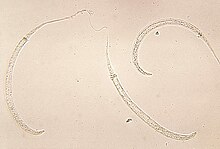| Guinea worm | |
|---|---|

| |
| Photomicrograph of larvae | |
| Scientific classification | |
| Domain: | Eukaryota |
| Kingdom: | Animalia |
| Phylum: | Nematoda |
| Class: | Secernentea |
| Order: | Camallanida |
| Family: | Dracunculidae |
| Genus: | Dracunculus |
| Species: | D. medinensis
|
| Binomial name | |
| Dracunculus medinensis | |
| Synonyms | |
Dracunculus medinensis (Guinea worm, dragon worm, fiery serpent[1]) is a nematode that causes dracunculiasis, also known as guinea worm disease.[2] The disease is caused by the female[3] which, at around 80 centimetres (31 inches) in length,[4] is among the longest nematodes infecting humans.[5] The length of specimens exhibits extreme sexual dimorphism, as the longest recorded male Guinea worm is only 4 cm (1+1⁄2 in).[4]
Guinea worm is on target to be the second infectious disease of humans to be eradicated, after smallpox. It was formerly endemic to a wide swath of Africa and Eurasia; as of 2023, it remains endemic in five countries: Chad, Mali, South Sudan, Angola and Ethiopia,[6] with most cases in Chad. Guinea worm spread to Angola c. 2018, and it is now considered endemic there. Infection of domestic dogs is a serious complication in Chad.
The common name "guinea worm" is derived from the Guinea region of Western Africa.
- ^ Chaudhury, Abhijit (2022). "Dracunculiasis". Textbook of Parasitic Zoonoses. Microbial Zoonoses. pp. 427–436. doi:10.1007/978-981-16-7204-0_41. ISBN 978-981-16-7203-3.
- ^ Knopp, Stefanie; Amegbo, Ignace K.; Hamm, David M.; Schulz-Key, Hartwig; Banla, Meba; Soboslay, Peter T. (March 2008). "Antibody and cytokine responses in Dracunculus medinensis patients at distinct states of infection". Transactions of the Royal Society of Tropical Medicine and Hygiene. 102 (3): 277–283. doi:10.1016/j.trstmh.2007.12.003. PMID 18258273.
- ^ Bimi, Langbong (2007). "Potential vector species of Guinea worm (Dracunculus medinensis) in northern Ghana". Vector-Borne and Zoonotic Diseases. 7 (3): 324–329. doi:10.1089/vbz.2006.0622. PMID 17767406.
- ^ a b Schmidt, Gerald D.; Roberts, Larry S. (2009). Roberts, Larry S.; Janovy, John Jr. (eds.). Foundations of Parasitology (8th ed.). McGraw-Hill. pp. 480–484. ISBN 978-0-07-128458-5.
- ^ bin Saleem, Talha; Ahmed, Irfan (2006). ""Serpent" in the breast" (PDF). Journal of Ayub Medical College Abbottabad. 18 (4): 67–68. PMID 17591014.
- ^ Control of Neglected Tropical Diseases team (2023). World Health Organization (ed.). Criteria for the certification of dracunculiasis eradication 2023 update. World Health Organization. pp. 9, 26. ISBN 978-92-4-007333-3.